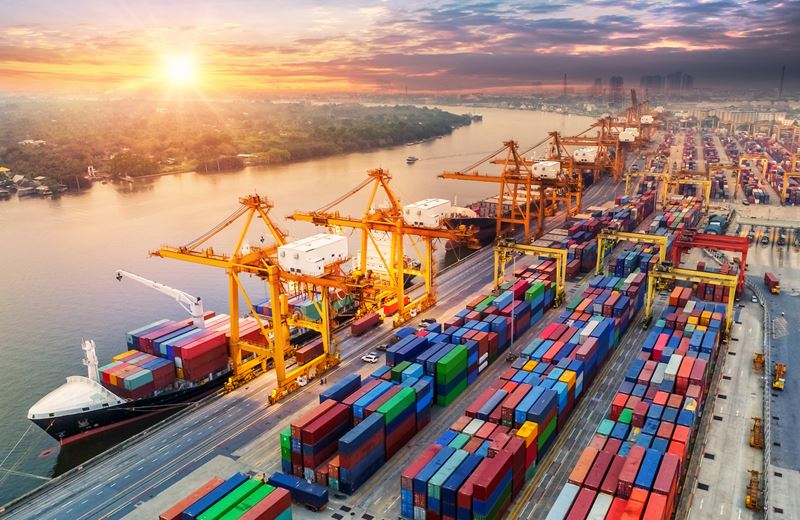Where is your supply chain most vulnerable?
Where is your supply chain most vulnerable?
Internal steps are the first line of defense for businesses to mitigate a multitude of risks. If you’re a manufacturer, for example, it’s up to you to keep your plant clean, your machines running smoothly, and your staff trained properly — all elements you can control.
The problem is that no manufacturer is an island. As part of a complex supply chain, your business is exposed to risks when your suppliers are exposed to risks. In 2019, more than half companies (51.9%) experienced a supply chain disruption over the last 12 months.1
As supply chains increasingly go global, few manufacturers have visibility into their supply chains, which makes risk mitigation even more challenging. In a global survey, 77% of manufacturers said they had no visibility or a restricted view of their supply chain, with only 6% saying they had complete visibility.2
While many supply chain disruptions are beyond your control, that doesn’t mean it’s impossible to protect your business. What you can do is get informed about all your suppliers along the chain and be aware of where your supply chain is vulnerable. Then, you can create a plan to mitigate those vulnerabilities and risks.
Here’s a look at 5 supply chain disruptions, followed by some key ways to help you prepare for the unplanned – and even the unexpected:
- Adverse weather events: Extreme weather and natural disasters such as floods, blizzards, hurricanes and wildfires, can wreak havoc on supply chains. Impacts include damage to facilities, resulting in temporary shutdowns; inventory damage; power failure and data loss; and blocked transportation routes. For example, the recent California wildfires shut down rail lines and trucking routes leading from major ports, causing logistics problems.3
- IT/telecoms outages: Unplanned IT and telecommunications outages, which can be caused by weather, human error, power failures or other events, were the number-one supply chain disruption in 2019, accounting for 44.1% of disruptions.4 Supply chains are increasingly reliant on technologies such as GPS tracking and wireless sensor networks to help deliver information that’s essential to decision-making. A disruption in access to real-time accurate data can cause a loss of time, profits, and customers.5
- Transportation network disruption: Whether caused by a natural disaster, a pandemic or a political issue, transportation network disruption can stop your supply chain in its tracks. The risks include interruption due to delay; damage, contamination, or loss of goods; customer service failures, and even regulatory compliance violations6—all of which can damage your corporate reputation and negatively impact profits.
- Cyber security: Your suppliers could be the weak link in your cyber security efforts. Research shows that 80% of organizations have suffered a breach that was caused by a third-party vendor in the past 12 months, and 77% have limited visibility into those vendors.7 Some other concerns include risks from poor information security practices by lower-tier suppliers, counterfeit hardware, and software security vulnerabilities in supply chain management or supplier systems.8
- Outsourcer service failure: As your company grows, you may choose to outsource work to an external service provider. Outsourcing can be an effective way to meet increased labour needs while maintaining lower costs, however, it’s not without its challenges. Some of the risks include low quality work because of a lack of direct oversight; lack of communication, for instance, there could be confusion over the requirements; and an inability to meet high expectations/standards because a service provider overstated their capabilities.9
In a global survey, 77% of manufacturers said they had no visibility or a restricted view of their supply chain, with only 6% saying they had complete visibility.
How to protect your business
Mitigating supply chain risks is complex and multi-faceted, but there are a few key tactics to consider. They include: conducting a supply chain vulnerability audit that identifies where the weak links are in your supply chain; diversifying supply chains from a geographic perspective rather than relying on a single geography or single supplier; making it a priority to have strong relationships and communications with suppliers; and evaluating alternative routes and logistics options.10, 11
While insurance coverage should be considered as part of your risk mitigation strategy, it’s important to note that supply chain disruptions are often not covered by your property policy. Specialty insurance coverages, such as Contingent Business Interruption or Product Recall, may be necessary to protect your business against supply chain risk. Your broker can help evaluate your supply chain risks and determine which coverages are appropriate for your risk exposures.
Sources
1,4 “BCI paints a mixed picture for supply chain risk management,” Commercial Risk, Nov. 7, 2019
2“GEODIS unveils its 2017 supply chain worldwide survey,” GEODIS, Nov. 5, 2017
3“Mitigate extreme weather effects on your supply chain,” IBM Supply Chain Blog, Dec. 2019
5 “These everyday disruptions could put your supply chain at risk,” Business Insider/UPS, Jan. 9, 2017.
6 “Mitigating supply chain risk: effective transportation and logistics provider diligence and management practices,” JD Supra, Sept. 18, 2017
7 “Supply chain attacks show why you should be wary of third-party providers,” CSO, Oct. 29, 2020
8 “Cyber supply chain risk management,” National Institute of Standards and Technologies, Updated June 22, 2020
9 “Five causes of outsourcing failures,” Flatworld Solutions,” Oct. 5, 2015
10“Combatting Ecommerce Supply Chain Disruptions and Steps You Can Take to Minimize Impact,” BigCommerce
11 COVID-19: Managing supply chain risk and disruption



